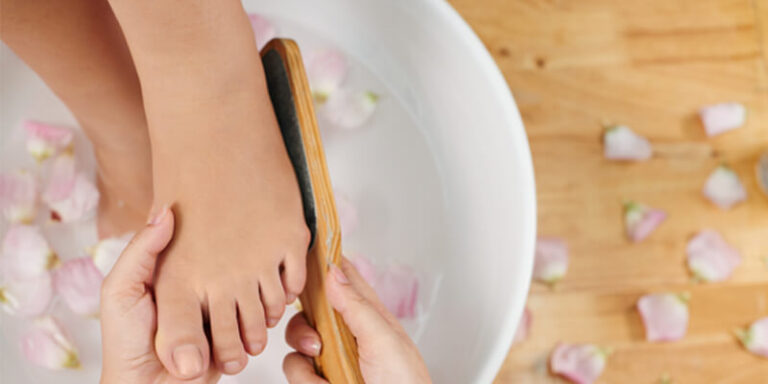Calluses on the feet are unsightly, annoying, and can cause pain if cracks form and, in the worst case, fissures. However, you cannot do without it either, and if you remove too much, the skin on the foot remains defenseless. This makes them more sensitive to pressure and friction, which can result in bubbles.
Table of Contents
How much cornea is healthy?
No one has to accept dry, cracked areas, but one should not rub the feet too aggressively with a grater or other means. In heavily used areas, the skin should have a certain roughness – then you are on the safe side. By the way, it is an old wives’ tale that calluses come back faster if you remove them frequently. Quite the opposite: Ideally, you should regularly take care of your feet, apply many creams to keep the skin supple, and gently remove the unloved callus gradually instead of removing too much at once in one quick action.
Tip: Make sure to apply lotion to your feet regularly! Special foot creams with urea and salicylic acid help against rough areas. You can use it thickly, put on cotton socks and let them soak in overnight! Creams with aloe vera are also a good choice and have a healing effect.
Footbath to remove the callus
In the first step, you should treat your feet to a foot bath, ideally with boiling or dead sea salt. This cleanses and has a germicidal effect. For very dry skin, an oil bath with urea (urea) is recommended. Baths with avocado oil also provide moisture.
However, you should not bathe your feet for more than 10 to 15 minutes. Otherwise, the skin will become too soft, and you can no longer properly see the transition from keratinized to healthy tissue. However, this is extremely important in order to remove the cornea in the next step.
Pumice stone, sponge, or callous plane?
There are numerous helpers in specialist shops to stop annoying calluses. Experts are still happy to recommend the good old pumice stone because, if misused, callous planes can quickly cause damage and penetrate deep layers of the skin. Callus sponges, with which you can gently remove the upper layers of skin after a foot bath, are better. (Electric) files coated with a kind of sandpaper are also a good choice (e.g., the Scholl Velvet Smooth Express Pedi, which switches off when the pressure is too high and can be cleaned under running water).
Important for all aids: You should be able to clean them easily. Because hygiene is the most important thing in foot care.
How Much Callus should I Remove?
Removing the right amount of callus takes a little dexterity. Ideally, you remove so much that the skin feels flexible again but does not hurt. Practice makes perfect. And again, apply plenty of creams afterward to keep the skin supple!
With very sensitive skin and only slight cornification, a foot peeling with coarse-grain baking soda, coconut oil, and sugar peeling or peeling with oil and coarse sea salt is often sufficient to gently remove the callus layers.
Home remedies for calluses
Mouthwash and vinegar
Listerine hack options is one of the most popular pins: The foot bath with Listerine and vinegar will actually help each cornea. To do this, mix equal parts mouthwash with vinegar and water and bathe your feet in it for about 10 minutes. Then rub the keratinized areas on foot with a towel and then apply lotion.
Baking soda
With baking soda, the calluses on the feet can be removed relatively easily and sustainably. Mix 3 teaspoons of baking soda with warm water and bathe your feet in it for about 10 minutes.
In addition, you can mix soda powder with a little water or a pH-neutral washing lotion to make a soda paste, with which you rub your feet. Leave on for five minutes, and then rinse off in a baking soda foot bath. Then apply the cream to your feet again!
Epsom salt
Epsom salt or magnesium sulfate is also suitable for the treatment of calluses. It is also known as Epsom salt and is available in pharmacies and health food stores. If you bathe your feet in a warm Epsom salt bath, it penetrates the skin barrier and accelerates the breakdown of protein in the skin cells, which loosens keratinized areas.
Chamomile
The classic home remedy for calluses is chamomile or chamomile packets. For a foot pack with chamomile flowers, about one tablespoon of chamomile flowers is wrapped in a cloth and drizzled with hot water until the cloth is completely soaked. This is applied to the keratinized areas for around 15 minutes, which can then be easily removed with a pumice stone.
Lemon
Lemons can also quickly remove dead skin thanks to the acid they contain. To do this, simply cut a lemon in half, place it on the cornea and leave it on for half an hour. Alternatively, a bandage soaked in lemon juice can do it.
Preventing calluses – the best tips
- ·Do not wear shoes that are too tight, ill-fitting, or too pointed because wearing the wrong footwear plays a decisive role in the development of calluses. High heels and very thin or hard soles should also be avoided if possible.
- Change shoes frequently so that the same areas are not always used.
- Regular foot baths.
- Walk barefoot as often as possible.
- Cream feet daily – special foot ointments with active ingredients such as urea and salicylic acid, marigold ointment, or deer sebum ointment are suitable.
- Every now and then, you should treat yourself to a foot massage.

